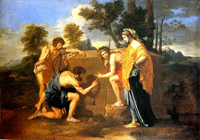The Pontils tomb in a Second Poussin-Painting?
The Art Book
In the beginning of April 2007 I was able to get hold of a copy of the art book Tout l’oeuvre peint de Poussin, written by Jacques Thuillier in 1974. In this book the author published a chronological list of all the paintings which the artist Nicolas Poussin made during his entire life. Each of these paintings is also portrayed as a small black-and-white tile (5cm x 6cm). Obviously there is also a picture in the book of Poussin’s most adored work Les Bergers d’Arcadie.
Today, art historians still don’t agree on the year in which the painting Les Bergers d’Arcadie was actually created. Grautoff plots the year of production around 1638-1639. According to Friedlaender it was painted at the beginning of the year 1640 or at the end of 1642, Mahon also suggests the year 1640, but the Poussin connoisseur Anthony Blunt states that it was probably made around 1650-1655. The author of the art book Thuillier is also of the opinion that the painting, also known by the name Et in Arcadia Ego, was painted in the period between 1638-1639 (Thuillier 1974).
Except for Blunt, all the art experts are in agreement that the painting Les Bergers d’Arcadie was created shortly before or during Poussin’s stay in Paris.
Poussin, who was born in France in the village of ‘Les Andelys’, spent the greater part of his life in Rome, Italy. Only from 1641 to 1642 Poussin was staying in the capital of France.
The painting Les Bergers d’Arcadie, which holds possible references to the tomb of Les Pontils near Arques, the mountain tops of Cardou and Blanchefort and to the hilltop of Rennes-le-Château, was created by Poussin around this Parisian period. Because of these alleged links to the enigma of Rennes-le-Château, I decided to look for other such possible elements in Poussin’s paintings portrayed in the art book by Thuillier before Poussin’s Parisian period.
The Discovery
After a while of fruitless searching, I had almost abandoned hope to find any references to Rennes-le-Château It was only then that I spotted this last painting, was painted shortly before Poussin’s departure to Paris:
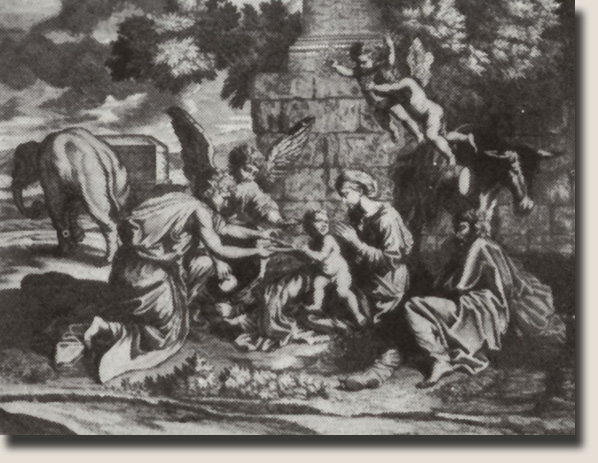
Le Repos Pendant la Fuite en Egypte à l'Eléphant by Nicolas Poussin
(Photo © Thuillier 1974)
The painting I stumbled upon, was known by the name of Le Repos Pendant la Fuite à l’Eléphant (Rest on the Flight to Egypt), and it depicts Joseph, Mary and the little baby Jesus having a rest during their flight to Egypt. This flight, which is described in the Gospels (Matthew 2: 13-15), was revealed to Joseph by God in a dream, urging him to escape from the massacre of the innocent children that was about to be kicked off by king Herod later on.
In itself the scene does not represent anything special. However, at the far the left of the painting halfway behind the elephant, there is a construction that bears a strong resemblance to the tomb of Les Pontils and the tomb portrayed in Les Bergers d’Arcadie!
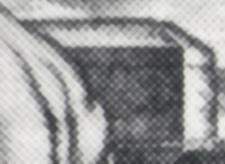
Close-up of the tomb in question
(Photo © Thuillier 1974)
Was there a similar tomb built in the South of France in the 17th century? And did Poussin immortalise this tomb in this painting just like he did in Les Bergers d’Arcadie? The tomb of Les Pontils was only constructed around 1920-1930 by a man named Louis Lawrence (Jarnac 1985), but rumours has it there once stood a similar construction in the very same spot which was destroyed by order of Louis XIV.
A Tomb
What else can this structure be than the tomb which is also depicted in Les Bergers d’Arcadie?
Since the scene that is represented in this work of art is staged in Egypt, I guessed Poussin possibly painted a deformed pyramid, not having sufficient knowledge of the form of Egyptian tombs, (which would be fairly understandable for those days). That idea is contradicted by an earlier work of Poussin Moïse Sauvé aux Eaux (Moses Saved from the Waters). In this painting Poussin did paint a proper pyramid.
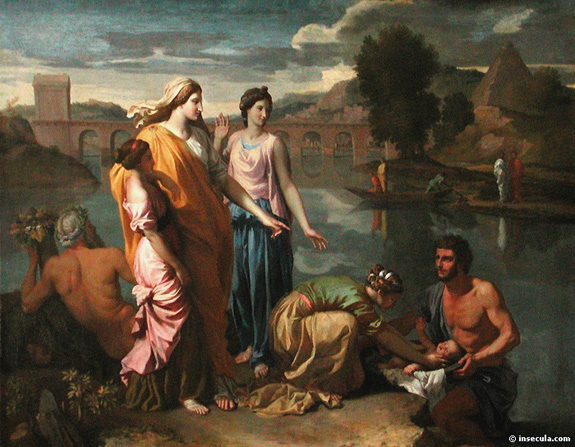
Moïse Sauvé des Eaux by Nicolas Poussin with pyramid
(Photo © www.insecula.com)
In other words: Poussin knew perfectly what a pyramid looked like. So the stone construction on Le Repos Pendant la Fuite à l’Eléphant is definitely not a deformed pyramid.
It is not a house either, because one cannot distinguish any windows or doors in it. I conclude that this structure is a tomb. Furthermore this tomb seems to have the same horizontal lines on the sides as appear on the tomb of Les Bergers d’Arcadie and on the tomb of Les Pontils.
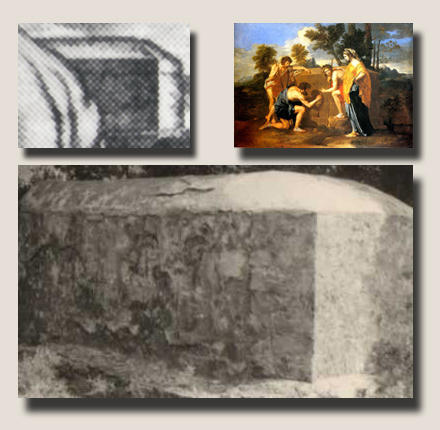
The three tombs
(Photo Pontils tomb © http://massagot.free.fr/)
A Missing Painting
For the moment the painting Le Repos Pendant la Fuite à l’Eléphant, that dates back to the period 1639-1640, is classified as ‘missing’ painting, since it is unknown where it is located for the moment.
No images even exists of the original painting. The photograph displayed here is not a picture of the painting itself, but of a (hopefully) truthful seventeenth century engraving made by un unknown artist.
Poussin probably painted the original for the Italian cardinal Rospigliosi (Thuillier 1974). This man would later be elected pope, carrying the name of Clement IX.
Conclusion
Whatever the truth may be, by the discovery of the tomb in this special painting and through this article I hope to inspire and encourage the discussions about Poussin’s possible involvement in the Les Pontils-Rennes-le-Château affair.
Het Rennes-le-Château Mysterie © 2007 - All rights reserved



